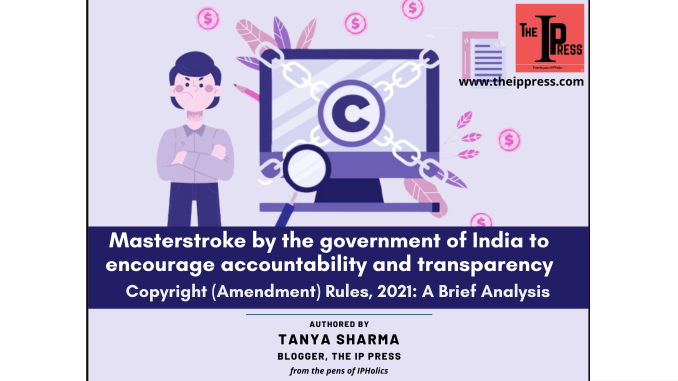
Copyright (amendment) rules, 2021: A Brief Analysis
“Copyright is the exclusive right granted by law for a certain number of years to make and dispose of and otherwise to control copies of a literary, musical or artistic work[1]”.
The copyright regime in India is governed by the Copyright Act, 1957 and the Copyright Rules, 2013 which was last amended in the year 2016. Now the Government of India has come up with Copyright (Amendment) Rules[2], 2021, which will bring the existing rules in parity with other relevant legislation and will encourage accountability and transparency.
Key Takeaways of Copyright (Amendment) Rules, 2021 are-
- The Copyright (Amendment) Rules, 2021 are notified vide Gazette notification[3] under reference G.S.R. 225 (E) dated 30th March 2021.
- A new provision has been inserted regarding the publication of a copyrights journal which states that the said journal would be available at the website of the Copyright Office instead of being published in the Official Gazette in order to provide smooth and flawless compliance in the light of the technological advancement in the digital era by embracing electronic means as the primary mode of communication and working in the Copyright Office.
- The Rules have introduced new provisions which would deal with the undistributed royalty amounts and the use of electronic and traceable payment methods while collection and distribution of royalties in order to encourage accountability and transparency.
- To help reinforcing transparency in the working of copyright societies[4], a new rule, i.e. Rule 65A has been incorporated wherein the copyright societies would be required to draw up and make public an Annual Transparency Report for each financial year within 6 months following the end of the financial year.
- The Copyright Board has been merged with the Appellate Board as the amendments have harmonized the Copyright Rules with the provisions of the Finance Act, 2017.
- The compliance requirements for registration of software works have been largely reduced (as earlier the language of Rule 70(4) required the applicant to submit the “source and object code” while making an application for registration of computer programme) wherein the applicant can file the first 10 and last 10 pages of source code, or the entire source code if less than 20 pages, with no blocked out or redacted portions.
- To examine the application more comprehensively, the time limit for the Central Government to respond to an application made before it for registration as a copyright society is extended to 180 days.
You may access the official copy of the Copyright (Amendment) Rules here.
[1] Webster’s Encyclopedic Unabridged Dictionary
[2] https://www.pib.gov.in/PressReleasePage.aspx?PRID=1710417
[3] https://copyright.gov.in/Documents/Notification/Copyright-Rules_Amendment_2021.pdf
[4] https://www.mondaq.com/india/copyright/1056724/copyright-amendment-rules-2021-key-takeaways

Leave a Reply